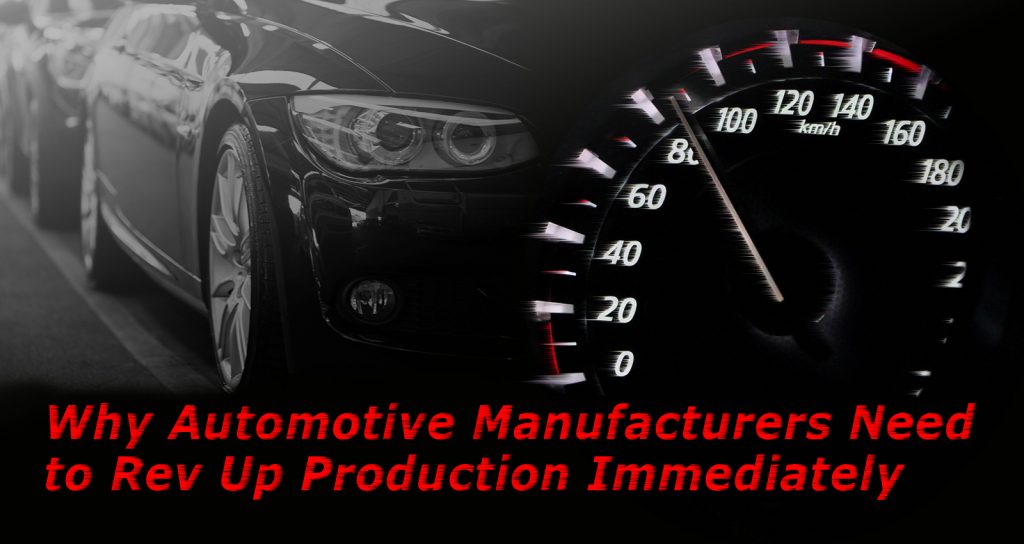
Why Automotive Manufacturers Need to Rev Up Production Immediately
It’s been a bumpy ride for the automotive industry this past year. Back in November and December when the economy was running full speed ahead, automotive manufacturers had high expectations for robust sales activity in 2020.
Then, COVID-19 happened.
With frightening speed, the economy ground to a halt as states, employers, and officials implemented various measures to slow the spread of the virus, which ultimately resulted in layoffs and reduced buying activity. In a typical year, the number of motor vehicles sold runs between 17 million and 20 million. But the sudden decline in car sales has analysts forecasting an overall light vehicle sales total of 14 million nationwide by this year’s conclusion, CNN reported. Perennial leaders in auto sales — such as General Motors, Ford and Chrysler — witnessed double-digit declines in quarterly sales compared to 2019. In response, automotive manufacturers slowed down output, a consequence of declining demand, assembly worker absences caused by COVID-19, and other supply chain disruptions.
Yet defying the odds, automakers appear to be back in the driver’s seat. As some of the coronavirus lockdowns and restrictions have lifted, the economy is in growth mode, with gross domestic product soaring at an annual rate of over 33% in the third quarter, according to the Bureau of Economic Analysis.
While car sales during this same period were lower than this time last year, they finished far better than experts anticipated, including Cox Automotive Senior Analyst Michelle Krebs.
“It’s coming in better than we thought,” Krebs told CNN.
Here’s the problem: Consumers may be back in a buying mood, but automakers still aren’t operating at peak capacity. As Car and Driver magazine reported this past summer, in response to the effects caused by the pandemic, numerous nameplates pushed the pause button on several all-new or upgraded product reveals. During the average year, the upcoming year’s car models start arriving on dealer lots in the late summer. In 2019, for example, 11% of motor vehicles available for purchase were 2020 models. Today, the latest models represent just 2%.
“Consumers may be back in a buying mood, but some automakers aren’t operating at peak capacity.”
“They’re just sort of behind,” Cox Automotive Senior Economist Charlie Chesbrough told Car and Driver. “The white-collar workers are behind in planning the model-year rollovers; the factories have had a difficult time getting the supply chain up to speed.”
The same is true for used and preowned automobiles. As Edmunds.com’s Jessica Caldwell pointed out in a press release, used vehicle parking lots had few to any buyers in them initially, but now, what was unsold is going fast.
The question becomes, then, what strategies and planning can automotive manufacturers implement to ramp up production so inventory issues don’t show up in 2021? The following recommendations may help:
Keep an ongoing maintenance schedule for equipment
While assembly workers is critical to increasing output, the equipment leveraged are the workhorses of auto manufacturer factories, increasing and streamlining production seamlessly. But when they’re not working or encounter repair issues, everything slows down. That’s why it’s important to adhere to a maintenance schedule so equipment is well lubricated and bolts are properly fastened. From semi-automated lifting machines to die gripper cranes, preventive maintenance is critical to avoiding issues that can prevent assembly teams from reaching their production goals in a timely manner.
Review current systems and processes
When it comes to solving problems, you first have to recognize exactly what those are and why they’re happening. When it comes to output for automakers, it’s really been a confluence of events brought on by the pandemic, economic instability that resulted and how manufacturers responded. However, with slight or significant tweaks on the factory floor, teams may be able to maximize how much they produce. By mapping current production processes, crews may be able to isolate where the problems exist and uncover bottlenecks. This type of review may all help identify potential bottlenecks so they can be resolved before they occur.
Consider developing new protocols to keep teams healthy
One of the issues that automotive manufacturers encountered throughout the pandemic was absenteeism. The virulence and contagiousness of COVID-19, the symptoms of which often are similar to influenza, led to fewer people on assembly lines, leaving others to pick up the slack. While most people fully recover from the illness, a lack of personnel naturally leads to a slowdown. Firms may want to think about installing measures that can help workers avoid the potential for becoming sick. Whether it’s daily health screenings like temperature checks, social distancing measures, personal protective equipment, or more regularly scheduled deep cleanings between shift changes, a healthy workplace is a productive workplace.
Perform investigation into more automation
Automation is already a standard part of many automakers’ production processes, given it helps to maximize output, reduce costs and virtually eliminate mistakes that result from human error. But as technology is in a constant state of advancement, there may be systems out there that are better than what you have now. None of this is to say you should invest in more automation, but smarter machines can not only increase the speed of output but improve quality control and give crews the ability to handle issues that automation can’t solve.
Using automation as a supplement to your personnel can help you identify quality control issues that they may miss. As IndustryWeek points out, numerous quality control studies tracing back to the 1970s show human inspectors find 80% of the defect in manufactured parts. Leveraging automation can pick up the difference to increase efficiency, consistency, and — above all else — productivity.
Diversify suppliers
Just like a major motion picture is more than the actors on screen, an automobile is made up of thousands of pieces, parts, metals and components. A supplier is bound to encounter supply chain issues at some point. Instead of relying on one, aim to diversify them so if one is out of what you need, you can pivot to a supplier that has the items necessary. Strategic sourcing is a discipline that is crucial to ongoing supply chain management.
From throughput to quality improvements or supply chain optimization, USC Consulting Group can help your company resolve issues and rev up your operations using the right methodologies. Contact us today to learn more.







